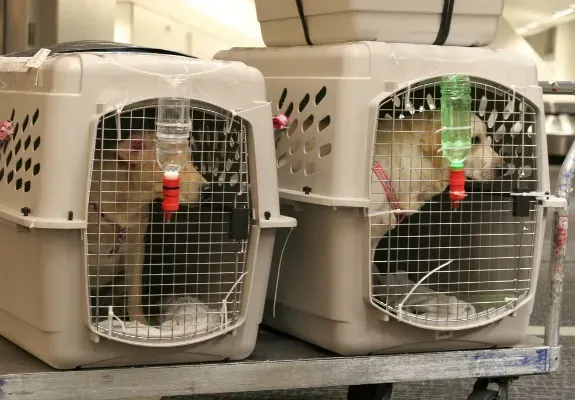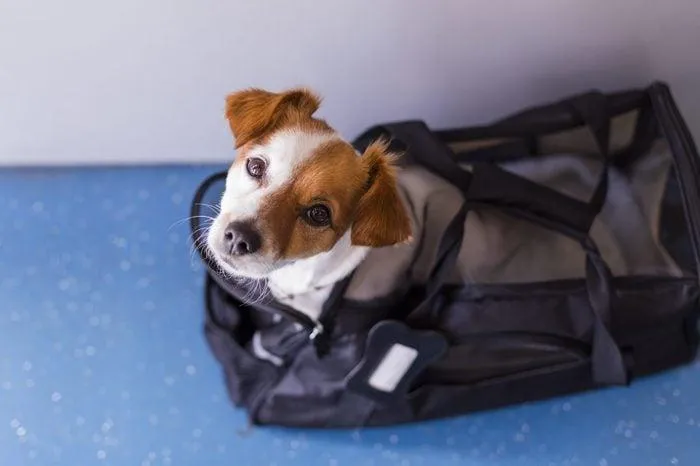A Comprehensive Guide to Flying with Your Dog
Whether you’re moving to a new home across the country or taking a vacation, you may be wondering can I fly with my dog? In this article, I will cover everything you need to know to travel by air with your furry companion.
Preparing Your Dog for the Trip
The first step is making sure your dog is comfortable traveling. From my experience working as a veterinarian, it’s best to get them used to their carrier well before the flight. Allow plenty of positive association by giving treats when they’re inside. You can also practice short car rides to get them familiar with the experience. Some dogs may need medication from your vet to help them stay calm on the plane.
Finding the Right Carrier
The carrier must be appropriated sized, sturdy, and have proper ventilation. Most airlines require it can be closed securely and not allow your dog to escape during the flight. Here are some good options to consider:
- Soft-sided carriers that are International Air Transport Association (IATA) approved
- Hard-sided carriers like plastic kennels
- Under-seat bags for small dogs
Test the carrier well in advance to ensure your pup is comfortable yet still adheres to size guidelines. Overhead bin space is limited, so an under-seat bag is preferable if your dog qualifies.
Booking Your Flight
Contact the airline directly as requirements can vary. Most accept one pet per passenger traveling in the cabin but advance notice is essential. You’ll need to provide:

- Your dog’s age, weight, and type of carrier
- Vaccination and health records from your vet
- Payment of any pet fees which often exceed $100 each way
Note certain breeds like brachycephalic dogs may have restrictions due to health risks at high altitudes. International flights also mandate microchipping and vaccines. Book early for best availability and give yourself a buffer in case of delays.
What to Bring Along
In addition to the carrier, pack these essential items:
- Two weeks’ worth of any medications, with prescription if needed
- Their favorite toy or blanket for comfort
- Several low-mess treats and squeezable pouches of food and water
- Poo bags and paper towels in case of accidents
- Collar, leash, and ID tag with your contact info
Also bring their vaccination records and rabies certificates in your carry-on in case asked. I’d advise extras of everything in case your luggage gets delayed. Dealing with a distressed pet without provisions would be incredibly stressful.
What to Expect at the Airport
Upon arrival, take your dog directly to the restroom if needed. Then check-in and obtain a boarding pass with your pet in carrier. Expect extra security screening which may involve opening the carrier for inspection. Remain calm and reassure your pup with affection despite any commotion.
Some friendly advice – consider giving them a potty break or calming treat right before boarding. Once on board, most airlines request the carrier be stowed under the seat or at your feet where the crew can easily see them. Every little thing helps to reduce anxiety for both of you during the flight.

In-Flight Tips and Considerations
The most common problem airlines encounter with pets is barking or crying that could disturb other passengers. One trick to help minimize this is to cover three sides of their carrier with a light blanket or towel. This muffles sound and blocks excess stimulation. Talk or play music softly for your pup to focus on you instead of any rumbling engines or movement.
If they seem uneasy, you can also offer treats, chew toys or try massaging their paws gently through the carrier. Never let them loose on the plane no matter how well-behaved normally. Outside accidents and injuries could endanger both them and people onboard. Most importantly stay positive, calm and low-key to reassure your fur baby throughout the flight.
Ground Transportation After Landing
Upon arrival, it may take longer to deplane with your pet carrier in tow. Have arrangements sorted for ground transport whether taking an Uber, shuttle or family pick up. Avoid excessive travel delays before allowing them to relieve themselves. My friend once made the mistake of getting stuck in traffic for over an hour after a coast-to-coast flight – needless to say it did not end well! With proper preparation, flying with pets is completely doable.
In summary, here are the key aspects to keep in mind for stress-free air travel with your dog:
- Get them accustomed to the carrier before the big day
- Meet airline guidelines for vaccines, size, fees and booking lead time
- Come fully prepared with supplies, records and backup contingencies
- Do everything possible to keep them calm throughout security, boarding and flight
- Have ground transport plans set to limittime before relieving themselves upon arrival
With some extra planning and TLC for your furry friend, flying shouldn’t be too awful of an experience. Most pups do surprisingly well once used to the routine. Just be certain to check all requirements for their health, safety and your peace of mind. Now go book that dream vacation with your best furry companion by your side!

I hope this covers everything a reader may want to know about can I fly with my dog. Please let me know if you have any other questions! Safe travels to all pet parents and their fur babies.
Can I Fly With My Dog: Requirements and Guidelines
| Airline | Size Restrictions | Crate Requirements | Health Records |
| Delta | Under 20 lbs, must fit under seat | Soft-sided kennel required | Up-to-date vaccinations |
| United | Under 20 lbs on lap, kennel for larger | Hard-sided kennel that secures for safety | Veterinarian health certificate within 10 days |
| American | Under 15 lbs on lap, kennel for larger | Hard-sided kennel that is leakproof | Rabies vaccination at least 30 days prior |
| Alaska | Under 20 lbs on lap, larger in cargo | Varies by route, contact for details | Vaccination record from vet within 1 year |
| Southwest | Under 20 lbs, in pet carrier under seat | Hard or soft-sided carrier that secures | Up-to-date vaccinations on file with vet |
FAQ
-
Can I bring my dog on the plane with me?
Most airlines allow you to bring your dog in the cabin of the plane as long as it fits under the seat in a carrier. The dog has to stay in the carrier for the whole flight. You’ll need to pay an extra fee too. Just be sure to check the rules for the specific airline you’re flying with before booking your trip.
-
Do I need any paperwork for my dog to fly?
Yes, you’ll need to show proof that your dog is healthy and up to date on all vaccinations. Make sure to bring your dog’s vaccination records showing they received rabies, bordetella, and canine distemper shots. The airline may ask to see this paperwork at check-in. Don’t forget to also bring your dog’s ID tag in case they get lost!
-
Is it safe for dogs to fly in cargo?
Flying in the cargo hold defiantly has more risks than flying in the cabin. However, according to experts, as long as your pooch is healthy and the kennel meets regulations, the peril is fairly small. Nonetheless, changes in air pressure and loud noises can possibly be a pretty miserable trip for pup. If you do have to fly your dog as cargo, consider talking to your vet about calming meds to make them more relaxed.
-
How much will it cost to bring my dog on the plane?
Costs can fluctuate based on the airline, but on average you can expect to pay around $125 each way for your dog to fly in cabin with you. Cargo fees are usually more pricey, ranging from $200 to $400. However, sometimes flying cargo works out cheaper than buying an extra plane ticket. So it pays to compare fees. You’ll also need to factor in the price of your dog’s airline approved travel crate.

-
What size carrier is allowed on planes?
Most airlines limit the size of carriers to no bigger than 18 inches long by 14 inches wide by 9 inches tall. Some may accept slightly larger, but nothing oversize. Make sure the carrier can slide under the seat in front of you with the lid closed. Test this out before your journey to be safe. It’s also a good idea to label your pet carrier and contact details on the outside in case it’s misplaced.
At the same time, some folks say it’s cruel to put dogs through the stress of air travel. But many veterinary experts believe that as long as proper precautions are taken, the risk to a healthy dog’s welfare is relatively tiny. “Is it worth putting pup through that for a fun trip?” you may wonder. Perhaps flying cargo allows giving man’s best friend the most comfortable ride possible? Speak to your vet and check airline rules thoroughly to decide what’s best for your doggy. Happy travels, Fido!
